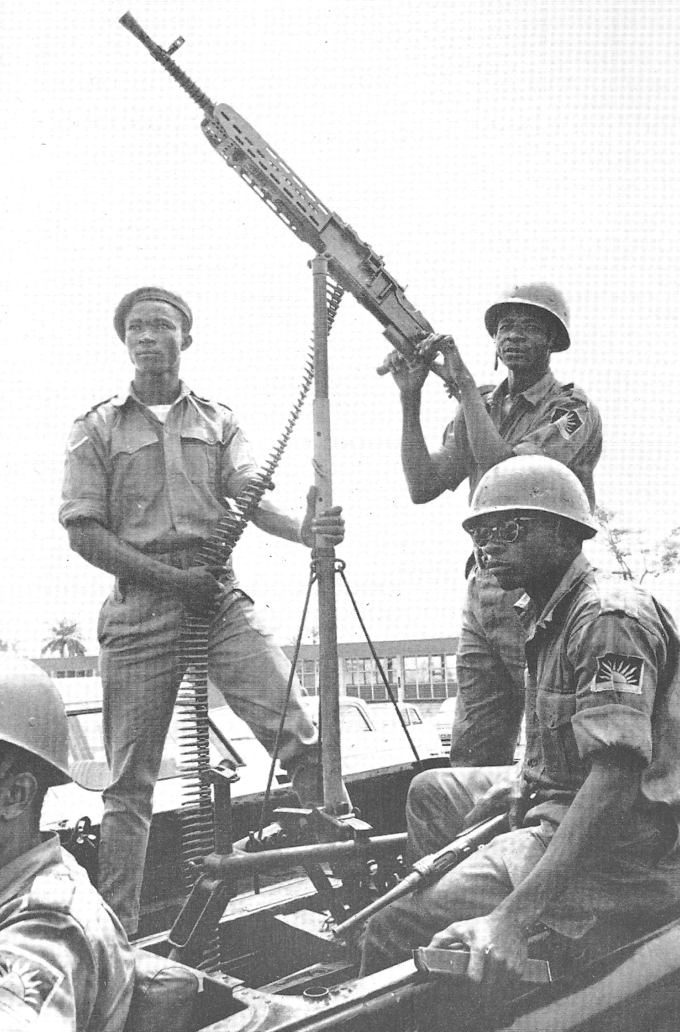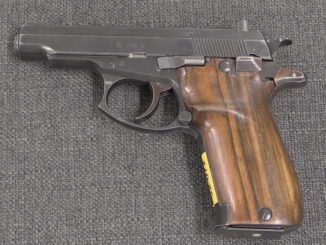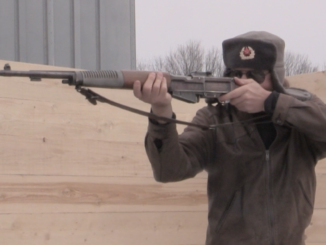The ZH-29 was the brainchild of noted Czech arms designer Emmanuel Holek in the late 1920s. It was one of the earliest practical and reliable semiauto rifles available, although Holek and the Brno factory were unable to secure any large orders for it (the three known orders total about 500 rifles, for China, Lithuania, and Ethiopia). Several other countries tested the rifle (including the United States), but none adopted it. The ZH29 was a long-stroke gas piston operated rifle with a tilting bolt which actually pivoted sideways into the left side of the receiver to lock. This design choice led to some unusual geometry to the gun, as the barrel is mounted at an angle to the receiver, so as to be perpendicular to the breech face when the bolt is in its locked position. Manufacturing quality was excellent on these rifles, and they all display a very pretty plum patina today. This particular example has no magazine with it, but my understanding is that ZB26 LMG magazines are a perfect fit.
Related Articles

Heavy MGs
Vintage Saturday: Short-Lived Nation
The Republic of Biafra was supported by Czechoslovakia during its brief existence, and the men here are equipped with a Czech ZB-53 machine gun and what appears to be a CZ-47 or CZ-247 submachine gun.

Semiauto pistol
Origins of the vz.82: A Western Pistol for Communist Czechoslovakia
The vz.82 and its cousin the CZ 83 are pistols that originated when the Czech state export company during the Cold War began looking for arms it could export to bring in hard currency. The […]

Semiauto Rifles
Shooting the Czech ZH-29 at James D Julia
The Czech ZH-29 is one of the first well developed semiauto military rifles – it was light, mechanically simple, reliable, and handled well, unlike many of its ungainly or excessively complicated predecessors. It only found […]

“Czechnology”? *groan* Nicely done, sir!
It seems like it wouldn’t take much wear on the rear sear for it to fail to catch the hammer. If that happened and the shooter didn’t release the trigger quickly I could imagine there would be a possibility of an unexpected second shot.
Also, is it the lighting or is the bluing on that rifle a fabulous shade of royal purple?
Im sure when the bolt comes forward, it actually presses the hammer enough to catch on the disconnector (note the hump on bottom in rear of the bolt). Puzzled me too.
If it disengaged due to wear the hammer would likely just roll over end of bolt as it would not contain enough energy to prime.
In general, my own perception is that speed of deliberate human action cannot match speed of energized mechanism.
Very good explanation Ian!
To tell you the truth, I never had a chance to see internals of this piece; if I say I am ‘flabbergasted’ is not strong enough. The amount of machining/ setup complexity is staggering. One of things I did not know is that this is long recoil operating system which should add to reliability.
The reddish tinge on receiver and barrel is probably due to heat treat process which is different than indigenous “brineer” (blackening).
The sideways lockup is probably repeated only on Guryunov HMG, afaik.
The gas system and locking system closely parallel that of the BAR, with the difference that the BAR of course has a separate pivoted locking piece attached to the bolt. You could almost call it a BAR action flipped on its side.
The standard magazine was a 10-round. Although I didn’t see a clip guide, that big open-topped receiver would certainly allow clip-loading by hand with little trouble with the rimless 7.9 x 57mm round.
Some experts have called the ZH-29 “over-complicated”, but it’s a good bit simpler than several of its contemporaries, like the Mauser G41M, the Walther G41W, the Pedersen “toggle action”, etc.
It just had the bad luck to be introduced at a time when most armies were still committed to bolt-actions. And the one that wasn’t, the U.S. army, had its own “in-house” design, the M1 Garand. Which fortunately for us was a good one.
One of the nastier historical “what ifs” would have been the Wehrmacht adopting this beast after the annexation of the Sudetenland and putting it into German-style mass production instead of fooling with the aforementioned Mauser and Walther rifles. That could have been a highly unpleasant surprise for the Red Army in June of 1941- as if they actually needed any more than they got historically.
cheers
eon
Germans had several programs going at that time in Brno. Also, the big part of preoccupation were Waffen SS and they always wanted something else. Result was postponement and not keeping schedules, which fit well into intentions of largely Czech staff.
It may be of interest that they were developing, among other things, fast firing cannon for submarines. This was after the war basis for double-barreled Skoda 30mm anti-air rig.
It seems the Czechs liked playing factions of the German occupation against each other… In any case, eon does have a point about nasty surprises, but the ZH-29 is still complex compared to the K98 and the MP-40. It doesn’t seem any more complex than the MG-34 or the MG-42, but it’s only a semi-auto, not a full-auto. Had this been adapted to become a select-fire battle rifle with a muzzle brake and simplified in the process to the point of adoption, could the Czechs have resisted the Nazi takeover for a longer period of time?
The Czechs could have resisted the Nazis just fine as they were. They were sold out at Munich and folded without a fight.
Okay, suppose Czechoslovakia retaliated by stabbing the occupying German soldiers in the back (or perhaps secretly sabotaged all the weapons the Germans took and poisoned their rations) and then rearmed and restarted real weapons production rather than allow itself to be stuffed into the broom closet? What would happen next? Would the war start too early and end with barbed wire and dead bodies over a cratered central Europe?
The Nazis could have been defeated quite easily in 1936, or 1938, or 1939 for that matter had the Western Allies possessed the will to actually fight. Just something to think about if you want to curse our own modern politicians for being spineless and short-sighted.
My opinion is that when taken in context with the period of development and the technology of that timeline, this is a very interesting weapon with many desirable attributes for a combat piece. The truth is that in many instances the Czech arms industry was willing to step WAY out of the box of traditional thinking. A prime example is in the development of “rocket propelled projectiles” preceding the ill-fated GyroJet. The Czechs, Germans, French, Americans and others were in a wild scramble near the end of WWII to develop such a class of weapon with prime examples being found at http://gigconceptsinc.com/Rocket-Czech-1a1b.html that includes documentation of their efforts as well as a commercial version in an electrically-fired sporting civilian rifle. This is a part of the website at http://gigconceptsinc.com/Rocket-Index-1a1a.html showing part of the international efforts in this realm and the level of development (This could have been solved with then-developing technology in other fields.) The latter was later shown to be the fault of one-dimensional thinking and complete lack of expertise in rocket design. The multi-nozzle configuration was the problem and not the overall concept. This could have been solved by reference to the Congreve Rockets (http://weebau.com/history/congreve_rock.htm and other sources) of “… by the rocket’s red glare …” note in our National Anthem. A partially plugged nozzle destabilized the projectile causing mechanical pronation and sometimes mid-flight tumbling. But as this subject weapon was the ancestor of later semi-automatic weapons, the “rocket bullet” was the predecessor of the tank-mounted gun-launched rocket round and the rocket assisted projectiles in use today.
Most interesting reference on Case-less of early time.
I made a copy of it and will read it; if there is interest, I could help with translation.
Love the beautiful radius’d machining/milling on the rifle.
The gun will fit all the ZB26 magazines.
The plum colour is caused when a case-hardened nickel steel is blacked.
There is two models of this, one with the rear sight as per example and one with the sight reversed.
The kick with this rifle is very unpleasant as it is relatively light for the power of the cartridge.
Out of interest the Japanese made a copy of this.
Denny: Are you saying that you can translate the original document? I would be interested in a better translation than is available to me at this time. The one I have was done by someone with only a passing acquaintance with American sentence structure and syntax but far better than nothing at all. I have been working on something related to this segment of arms design/operation and would appreciate any information from this or any related source. At present I have information such as “Base Bleed” with data from Dr. Gerald Bull (HARP Project), most of the HARP Documentation, interrogations of Dr. Heinrich Langweiler (Impulse Propulsion) and others. What I could use now is any practical experimentation data from the original researchers. Sometimes the least impressive notation is a new key to understanding. Thanks in advance …
Sure Bill. Ask Ian for my email.
Thanks.
I’m glad it’s that expensive. If it was worth up to the value of my car, I’d bid on it. My wife might actually kill me.
Mentioned that only THREE customers (China, Ethiopia, and Latvia???) —(Many)Years ago, Guns Magazine reviewed a Siamese Marked ZH29 …was it a “One off” as the Siamese (Thailand) had a habit of trialling various designs. The rifle was Thai script marked, so several may have been acquired…The ZH29 was made in 7,9mm, 7mm, ?7.65mm? and for the US Trials, .276 Pedersen. The Siamese Charkra marked example was in 7mm (7×57).
ZB also issued a PI version, the ZH31, of which China may have acquired some.
As to the Magazine, the use of the ZB26 mag as a replacement for the ZH29s original 10 round mag., was a bit of Tactical Fore-sight on the part of the designers…FN later made their 20 and 30 round Mags interchangeable between FAL and FALO; the Brits, when they converted the .303 Brens to 7,62, used a Curved FAL-L1A1 compatible Mag, whilst the Australians simply made a straight 30-round L2A1 Mag (for HB) as well as for their L4 Brens.
There are several ZH29 at the Beijing Jun-shi Bowuguan ( Military Museum).
Doc AV
Doc AV
My understanding is that the Soviet SG-43 machine gun also used a bolt tilting into the side of the receiver.
that spring loaded forward lockup for the magazine is brilliant, why isn’t this a thing on modern AK/FALs? could jam the magazine in instead of this silly rock and lock
I’m still trying to figure out why the ZH-29 Semiauto Rifle had to have the barrel mounted at an angle to the receiver. Would it have made it too bulky to shift the bolt assembly over? The asymmetrical appearance of the sights is disturbing to my eye.